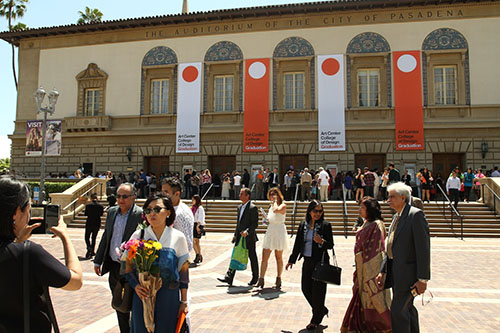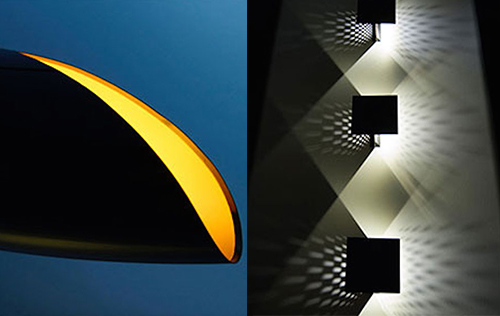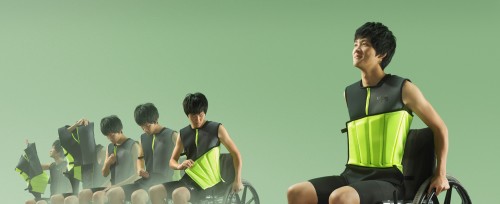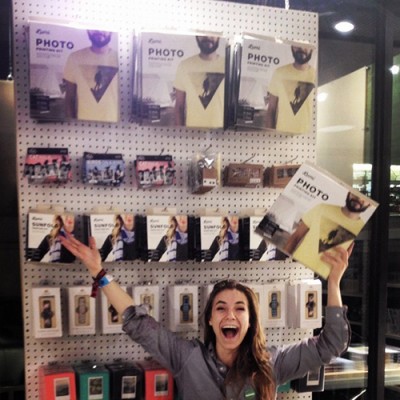Though the hum of activity in the halls and classrooms of Hillside and South campuses has temporarily lulled as we await the start of the Fall term, Summer 2015 has ended on a high note with this week’s news that ArtCenter students’ innovative prototypes and projects were honored by the prestigious Industrial Designers Society of America (IDSA) at the organization’s International Design Excellence Awards (IDEA) in Seattle on August 22.
Category Archives: Product Design
Student designers incorporate quantified self metrics into mind-bogglingly innovative devices for people with disabilities

Panoramic shot of students in the Envisioning the Quantified Self class
Graphic Design student Leah Demeter found herself in the unique position of acting as both designer and potential consumer in one of her recent product design classes at Art Center. That’s because her team had chosen a challenge particularly relevant to her: develop a better captioning device for the hearing impaired.
“As someone with profound hearing loss,” Demeter says, “I face communications challenges on a daily basis. Captioning is one of the tools I use to help me follow conversations I would otherwise miss, but there are problems with the current design.”
You go, grads: Let the Summer Graduation festivities begin!

Graduating students with friends and family following Spring 2015 commencement. Photo: John Dlugolecki
“Sun is shining. Weather is sweet. Make you wanna move your dancing feet.” Bob Marley
This Saturday, following a sometimes exhaustive, always intensive, memorably vigorous and astonishingly creative commitment to making and learning, 91 ArtCenter students will receive their diplomas. This will be the second graduation ceremony to be held at the Pasadena Civic Auditorium, a thankfully climate-controlled venue conveniently located between Hillside and South campuses.
As the day approaches, let’s celebrate these creative and talented individuals who are about to take on the world. Here’s the lowdown for the week:
View from the Bridge: Reflecting on #ADA25, inclusive design and Ed Roberts’ pivotal role as a pioneer for independent living

Ed Roberts in 1976 being sworn in by California Governor Jerry Brown as the State Director of Rehabilitation. Photo courtesy of the Metropolitan Transportation Committee
Last month marked the 25th anniversary of the Americans with Disabilities Act, a groundbreaking piece of civil rights legislation that prohibits discrimination against people with disabilities and guarantees that those individuals are afforded the same opportunities as everyone else. Or, as the Justice Department puts it, the Act guarantees that people with disabilities can “participate in the mainstream of American life.”
This anniversary means a great deal to me. Prior to coming to ArtCenter, I spent five years deeply involved in the development and building of the Ed Roberts Campus. This stunning and groundbreaking facility, situated atop the Ashby BART Station in Berkeley, was created by a number of disability organizations to serve as the global resource for the disability community.
The man whose name graces the campus, Ed Roberts, inspired the independent living movement and is widely considered the father of the Americans with Disabilities Act. His story is both thought provoking and exhilarating.
All you need to know about the value of mixing business and design from Airbnb’s Katie Dill
Doreen Lorenzo: What do you think influenced your career path and becoming a designer?
Katie Dill: Growing up my sister and I were chopping wood, helping to build the extension on the house, taking down trees, driving cars when we were nine years old, and just playing outside in the Adirondacks, making things, like forts and whatever would come to us. And so it was very hands-on—if you see a problem, fix it. I think that kind of approach took me onto the design route, which is all about problem solving and making things.
I’d never even heard of the profession of design, outside of interior design. I studied history in college, because I wanted to know why things are the way they are, and graduated looking to try to understand my next step. While I was studying abroad in Florence I fell in love with architecture, so I started to explore that as a career, speaking to several different architects, trying to learn how they got into it and what they did. That’s when I realized it probably would not be a good profession for someone as impatient as me.
My roommate recommended I talk to industrial designers, and when I did, I realized it sounded like a dream job come true. I applied to school and was accepted at Art Center College of Design. I studied industrial design and did a study abroad at a business school, INSEAD in Singapore, and then did several internships that took me further into the business world.
I saw how MBA students would tackle problems a designer could tackle, but in a different way. And I saw their way of thinking versus our way of thinking, and how together we could do something really great. That energized me to unite the fields. Because it’s not enough to just imagine a beautiful thing. It’s all about: how does that thing fit in the larger ecosystem? What’s the impact going to be on the community? What’s the impact going to be on the business?
Later when I went to work at frog design, I came in as what they called a design analyst. And I started doing more interaction work, and more design strategy, leading design projects. And then from there, after five years at frog, I was leading teams and building teams. Now my design project at Airbnb in many ways is helping to design the team that creates all of our digital products.
To read more about Katie’s experiences transitioning from agency to corporate design work, managing change at Airbnb and her ever expanding definition of what it means to be a designer in today’s world, visit FastCoDesign.
Extra! Extra! May-June Art Center alumni notes are hot off the press

Laura Leiman’s RAAC project
Here’s your early summer bounty of Art Center alumni notes, news and happenings, best enjoyed with a cool beverage, under a shady tree on a breezy afternoon.
Celebrating the ADA’s 25th birthday with a primer of inclusive design at Art Center
- Kira Song’s floatation vest for brain-injured athletes with limited motion.
As the nation prepares to celebrate the 25th anniversary of the Americans with Disabilities Act (ADA) on July 26, the community of makers at Art Center College of Design continues to innovate products and experiences that help improve the world for people who have essential life function limitations.
Since its founding 85 years ago, students, faculty and alumni have been making a difference through inclusive design by applying a human-centered theory to assistive products and experiences for populations challenged by issues of aging, race, gender, ability, chronic disease, psychological or developmental disorders, and more.
“We have a community of students who want to leverage their creativity to impact people’s lives,” said Product Design Chair Karen Hofmann (BS 97 Product) who has guided designers making significant contributions through rethinking how products can improve people’s lives for more than a decade. “That’s the most meaningful work designers can do.”
Design polymath Michael Sans immerses Bikini Berlin in a high-intensity trans-disciplinary experience

Michael Sans with Art Center students in Berlin
“Inspiring and helping each other goes both ways,” says Product Design alumnus Michael Sans of his engagement with students at Art Center Bikini Berlin, the College’s satellite studio where he is managing director.
Sans’ own education began at the workbench of his woodworker grandfather in a small German town on the Rhine. He apprenticed as a cabinetmaker, briefly studied architecture in Florence, and turned to product design when he entered the program at Art Center Europe in Switzerland—emerging forever shaped by its “professional approach, intense schedule, small classes and perfect facilities.”
Illuminating Lumi: charting a startup’s path from Shark Tank to Y Combinator to VC funding
When 16-year old Jesse Genet began printing tee shirts in her parents’ basement, the enterprising teen could have scarcely fathomed a future in which her bright idea would morph into Lumi, a company with $2.5 million in sales, which appeared on ABC’s Shark Tank, earned a coveted spot in Silicon Valley’s hottest startup incubator Y Combinator (think Airbnb, reddit, Dropbox) and has just closed on a seed venture round of financing.
Jesse and Lumi business partner Stephan Ango met as Product Design students at Art Center. Before starting college, however, Jesse was a natural-born entrepreneur who sought out a better way to print photography on textiles. A ton of research led her to a reference about a dye process that intrigued her and eventually led her to the man who owned the rights to the dye and the last inventory of the substance. She first contacted him while still in high school. “He didn’t take me seriously at first,” Jesse recalls. “After all I was just a high school kid. It wasn’t until Stephan and I joined forces and we made several trips to Northern California to meet with him that he finally began to negotiate with us seriously.” Continue reading
Students stir emotion with light and shadow at Salone del Mobile 2015

Inspired by invisible depths of both light and shadow in urushi, the “Continuum” family of luminaires is a meditation on the seamless relationship between light and shadow. By Connie Bakshi, Kouichi Miyazaki
Mokume lights that use wood grain to reveal the passage of time. Pendant lights that echo the ephemeral life of the raindrop. Porcelain luminaires that freeze calligraphy, revealing the beauty of the form’s imperfections. These are a few of the projects that emerged from the 9th annual Pacific Rim international collaboration between Art Center and Tama Art University in Tokyo. Hosted and lead by the Environmental Design Department, Pacific Rim challenges students from both schools each year to collaborate to envision new lighting designs by exploring the way light impacts the way we perceive our world, influences our mood and colors our experiences. This year’s collaboration encouraged students to investigate the sensorial qualities of light and shadow within the context of Japanese history, tradition and culture. Continue reading


